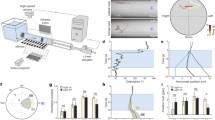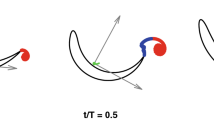Abstract
Experiments are reported on the hydrodynamics of a swimming robotic lamprey under conditions of steady swimming and where the thrust exceeds the drag. The motion of the robot was based on the swimming of live lampreys, which is described by an equation similar to that developed for the American eel by Tytell and Lauder (J Exp Biol 207:1825–1841, 2004). For steady swimming, the wake structure closely resembles that of the American eel, where two pairs of same sign vortices are shed each tail beat cycle, giving the wake a 2P structure. Force estimates suggest that the major part of the thrust is produced at or close to the end of the tail.












Similar content being viewed by others
References
Buchholz JH, Smits AJ (2007) On the evolution of the wake structure produced by a low aspect ration pitching panel. J Fluid Mech 546:433–443
Kern S, Koumoutsakos P (2006) Simulations of optimized anguilliform swimming. J Exp Biol 209:4841–4857
Lighthill MJ (1971) Large-amplitude elongated-body theory of fish locomotion. Proc R Soc Lond B 179:125–138
Müller UK, Smit J, Stamhuis EJ, Videler JJ (2001) How the body contributes to the wake in undulatory fish swimming: flow fields of a swimming eel (anguilla anguilla). J Exp Biol 204:2751–2762
Triantafyllou GS, Triantafyllou MS, Grosenbaugh MA (1993) Optimal thrust development in oscillating foils with application to fish propulsion. J Exp Biol 7:205–224
Tytell ED (2004) The hydrodynamics and eel swimming ii: effects of swimming speed. J Exp Biol 207:3265–3279
Tytell ED, Lauder GV (2004) The hydrodynamics and eel swimming 1: wake structure. J Exp Biol 207:1825–1841
Williamson CHK, Roshkol A (1998) The hydrodynamics and eel swimming ii: effects of swimming speedvortex formation in the wake of an oscillating cylinder. J Fluid Struct 2:355–381
Acknowledgments
This study was supported by NIH CNRS Grant 1R01NS054271. Dr. Eric Tytell helped guide our research through many useful discussions and access to data and research methods. Our interactions with Professors Avis Cohen and Phil Holmes continue to be invaluable. The first robotic lamprey was built by Annora Bell and Ed Sheldon, and it was subsequently improved by Steve Batis.
Author information
Authors and Affiliations
Corresponding author
Rights and permissions
About this article
Cite this article
Hultmark, M., Leftwich, M. & Smits, A.J. Flowfield measurements in the wake of a robotic lamprey. Exp Fluids 43, 683–690 (2007). https://doi.org/10.1007/s00348-007-0412-1
Received:
Accepted:
Published:
Issue Date:
DOI: https://doi.org/10.1007/s00348-007-0412-1




